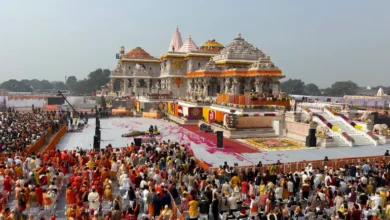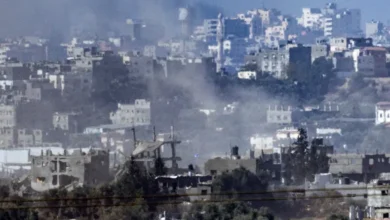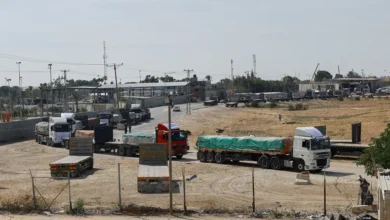Bezalel Smotrich’s ancestors would have told him he was lying
Lorenzo Kamel

Lorenzo Kamel
Israel’s Finance Minister Bezalel Smotrich dismissed the existence of a Palestinian people and history in a speech he delivered in Paris on March 19.
Born in 1980 in Haspin, a settlement in the occupied Golan Heights, Smotrich made these remarks from a lectern wrapped in a flag that showed Jordan, the West Bank and the Gaza Strip as part of Israel.Also on the stage next to Smotrich was a picture of the founder of Revisionist Zionism, Vladimir Jabotinsky.
A century ago, in November 1923, Jabotinsky himself used words that seemed to suggest a very different understanding of Palestine to the one Smotrich has outlined.
“There can be no voluntary agreement between ourselves and the Palestine Arabs […] it is utterly impossible to obtain the voluntary consent of the Palestine Arabs for converting ‘Palestine’ from an Arab country into a country with a Jewish majority,” Jabotinsky wrote.
“Every native population in the world resists colonists as long as it has the slightest hope of being able to rid itself of the danger of being colonised”.
Jabotinsky’s words remind us that the extremists of the 1920s had no problem recognising the existence of the Palestinians, nor that of what has been known as Palestine for many centuries.
Conversely, the current Israeli finance minister, whose family is of Ukrainian origin (Smotryc is the name of a town in western Ukraine), claimed that his grandfather, “who was the 13th generation in Jerusalem, was a true Palestinian”.
Thirteen generations correspond to about 300 years if not more. This means that, according to the family tree provided by Smotrich himself, some of his ancestors may have met the mufti Khayr al-Din al-Ramli, an influential lawyer in 17th-century Ottoman Palestine, who lived in the city of Ramla from which he drew his surname.
They might have also come across al-Ramlī’s manuscripts (Jews in Palestine spoke Arabic in their daily life), and the concept of “Filastin”, which al-Ramlī referred to as “biladuna” (“our homeland”).Unsurprisingly, Filastin was commonly referred to in much older works too, including in al-Uns al-Jalil bi-Tarikh al-Quds wa’l-Khalil (The glorious story of Jerusalem and Hebron), written around 1495 by the Qadi of Jerusalem Mujir al-Din, who used the expression “‘Ard Filastin” (the Land of Palestine) 22 times.A text from the 8th century, attributed to the scholar Abu Khalid Thawr Ibn Yazid al-Kalaai, argued that “the holiest place on Earth is Syria; the holiest place in Syria is Palestine; the holiest place in Palestine is Jerusalem [Bayt al-Maqdis]”.
Detailed references to Palestine, not necessarily of a strictly religious nature, can be found in a series of other manuscripts from the 9th and 10th centuries too. “Filastin”, wrote the Persian geographer al-Istakhri, “is the most fertile among the Syrian provinces.”
“At its maximum extension [Filastin goes] from Rafah to the edge of Al Lajjun (Legio), a traveller would need two days to travel across its entire length; and [this is also] the time [necessary] to cross the province across its breadth from Jaffa to Riha (Jericho),” he wrote.
But who lived on this land in previous centuries, alongside some of Smotrich’s ancestors?
The first official census in Palestine was conducted by the British authorities in 1922. A total population of 757,182 individuals was found, of whom 590,890 were Muslims, 83,794 were Jews, and 73,024 were Christians.The most reliable estimates of the previous century reveal that in 1800 the total population of Palestine numbered 250,000 individuals, reaching 500,000 in 1890. As noted by American demographer Justin McCarthy, of the 411,000 inhabitants in Palestine in 1860, the overwhelming majority were Sunni Palestinians, with important “minorities” – in particular Christian, Shia and Druze – present.
They used the Ottoman lira (before 1844, the common currency was the kurush), spoke Arabic and lived scattered among 700 villages, demonstrating their bond to their land “with the tenacity of aboriginal inhabitants”, in the words of British writer Elizabeth Finn, who was the wife of the British consul in Jerusalem in the mid-19th century.
The villages were located mostly in the hilly and mountainous regions that stretch from north to south between Galilee and Jabal al-Khalil (Hebron). This was mainly due to safety and health reasons: The flat regions, like the coastal area, were more exposed to the periodic raids by Bedouins, as well as to the proliferation of illnesses such as malaria.
The rest of the population lived in mixed cities – where also most of the Jews of Palestine lived – like Jerusalem, Haifa, Tiberias, Jaffa and Safad. Or in fully non-Jewish cities such as Nazareth, Shefaraam, Nablus (which in the 18th and 19th centuries was the most prosperous city in the region), Yaffa, Beisan, al-Lidd, Ramla, Ramallah, Bir al-Saba, Beit Jala, Jenin, Khan Younis, Gaza, Bethlehem, Acca and Tulkarem.
These layers of history won’t disappear, nor will they be “wiped out”, as happened to 450 Palestinian villages in 1948, and, more recently, as was suggested by Smotrich himself in relation to the Palestinian village of Huwara.










